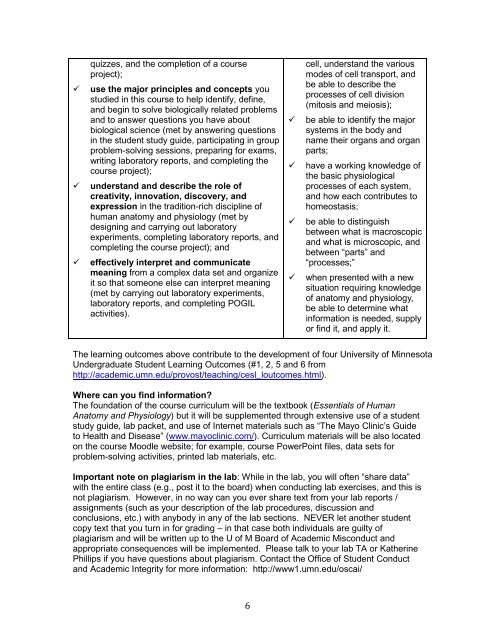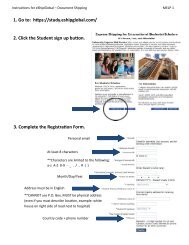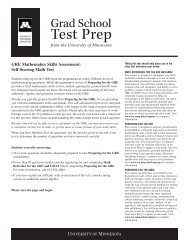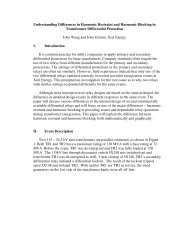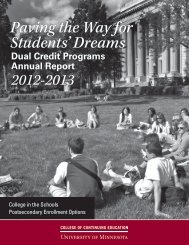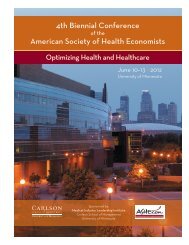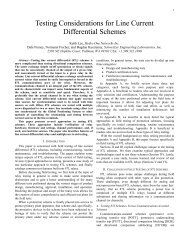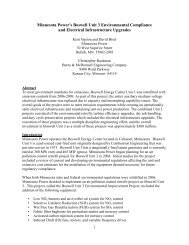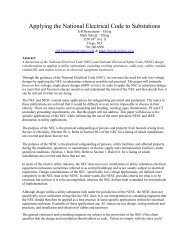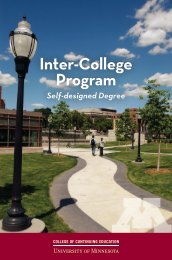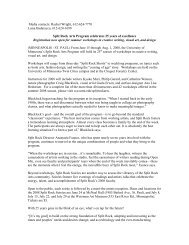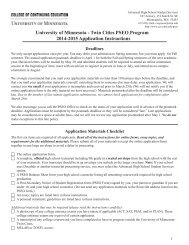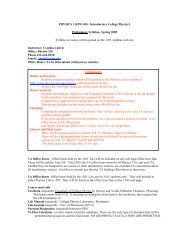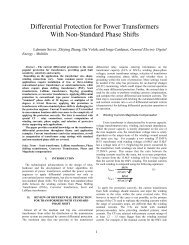PsTL 1135: Essentials of Human Anatomy and Physiology
PsTL 1135: Essentials of Human Anatomy and Physiology
PsTL 1135: Essentials of Human Anatomy and Physiology
- No tags were found...
You also want an ePaper? Increase the reach of your titles
YUMPU automatically turns print PDFs into web optimized ePapers that Google loves.
quizzes, <strong>and</strong> the completion <strong>of</strong> a courseproject);use the major principles <strong>and</strong> concepts youstudied in this course to help identify, define,<strong>and</strong> begin to solve biologically related problems<strong>and</strong> to answer questions you have aboutbiological science (met by answering questionsin the student study guide, participating in groupproblem-solving sessions, preparing for exams,writing laboratory reports, <strong>and</strong> completing thecourse project);underst<strong>and</strong> <strong>and</strong> describe the role <strong>of</strong>creativity, innovation, discovery, <strong>and</strong>expression in the tradition-rich discipline <strong>of</strong>human anatomy <strong>and</strong> physiology (met bydesigning <strong>and</strong> carrying out laboratoryexperiments, completing laboratory reports, <strong>and</strong>completing the course project); <strong>and</strong>effectively interpret <strong>and</strong> communicatemeaning from a complex data set <strong>and</strong> organizeit so that someone else can interpret meaning(met by carrying out laboratory experiments,laboratory reports, <strong>and</strong> completing POGILactivities).cell, underst<strong>and</strong> the variousmodes <strong>of</strong> cell transport, <strong>and</strong>be able to describe theprocesses <strong>of</strong> cell division(mitosis <strong>and</strong> meiosis);be able to identify the majorsystems in the body <strong>and</strong>name their organs <strong>and</strong> organparts;have a working knowledge <strong>of</strong>the basic physiologicalprocesses <strong>of</strong> each system,<strong>and</strong> how each contributes tohomeostasis;be able to distinguishbetween what is macroscopic<strong>and</strong> what is microscopic, <strong>and</strong>between “parts” <strong>and</strong>“processes;”when presented with a newsituation requiring knowledge<strong>of</strong> anatomy <strong>and</strong> physiology,be able to determine whatinformation is needed, supplyor find it, <strong>and</strong> apply it.The learning outcomes above contribute to the development <strong>of</strong> four University <strong>of</strong> MinnesotaUndergraduate Student Learning Outcomes (#1, 2, 5 <strong>and</strong> 6 fromhttp://academic.umn.edu/provost/teaching/cesl_loutcomes.html).Where can you find information?The foundation <strong>of</strong> the course curriculum will be the textbook (<strong>Essentials</strong> <strong>of</strong> <strong>Human</strong><strong>Anatomy</strong> <strong>and</strong> <strong>Physiology</strong>) but it will be supplemented through extensive use <strong>of</strong> a studentstudy guide, lab packet, <strong>and</strong> use <strong>of</strong> Internet materials such as “The Mayo Clinic’s Guideto Health <strong>and</strong> Disease” (www.mayoclinic.com/). Curriculum materials will be also locatedon the course Moodle website; for example, course PowerPoint files, data sets forproblem-solving activities, printed lab materials, etc.Important note on plagiarism in the lab: While in the lab, you will <strong>of</strong>ten “share data”with the entire class (e.g., post it to the board) when conducting lab exercises, <strong>and</strong> this isnot plagiarism. However, in no way can you ever share text from your lab reports /assignments (such as your description <strong>of</strong> the lab procedures, discussion <strong>and</strong>conclusions, etc.) with anybody in any <strong>of</strong> the lab sections. NEVER let another studentcopy text that you turn in for grading – in that case both individuals are guilty <strong>of</strong>plagiarism <strong>and</strong> will be written up to the U <strong>of</strong> M Board <strong>of</strong> Academic Misconduct <strong>and</strong>appropriate consequences will be implemented. Please talk to your lab TA or KatherinePhillips if you have questions about plagiarism. Contact the Office <strong>of</strong> Student Conduct<strong>and</strong> Academic Integrity for more information: http://www1.umn.edu/oscai/6


